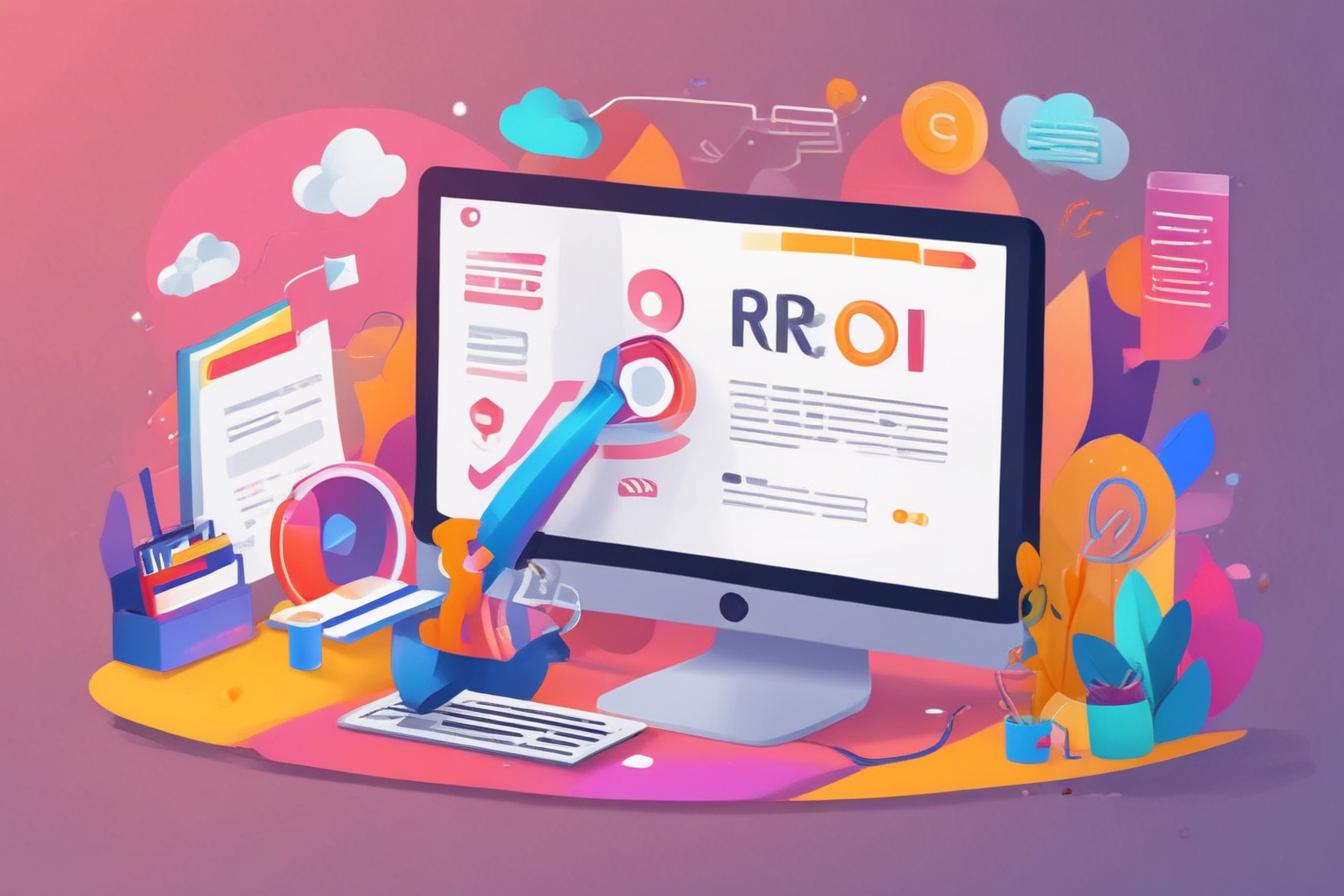What is the ROI of Content Marketing?
Content marketing is a strategic approach that focuses on creating and distributing valuable, relevant, and consistent content to attract and retain a clearly defined audience, ultimately driving profitable customer action. In an increasingly crowded digital landscape, businesses are turning to content marketing to cut through the noise, build brand awareness, and establish themselves as thought leaders in their respective industries.
Return on Investment (ROI) is a crucial metric that measures the profitability and effectiveness of any marketing campaign, including content marketing initiatives. Essentially, it quantifies the revenue generated from content marketing efforts against the costs incurred in creating and promoting that content.
The Benefits of High-ROI Content Marketing
When done right, content marketing can yield significant returns, making it a worthwhile investment for businesses of all sizes. Here are some key benefits of high-ROI content marketing:
- Increased brand awareness and credibility
- Improved search engine visibility and website traffic
- Higher lead generation and conversion rates
- Stronger customer relationships and loyalty
- Cost-effective compared to traditional marketing channels
Challenges in Measuring Content Marketing ROI
Despite its numerous advantages, measuring the ROI of content marketing can be a complex task. Unlike traditional advertising, where the direct correlation between spend and sales is easier to track, content marketing involves a more nuanced and long-term approach. Some common challenges include:
- Attributing revenue to specific content pieces
- Accounting for the compounding effects of content over time
- Quantifying intangible benefits like brand awareness and thought leadership
- Aligning content marketing efforts with broader business goals
To overcome these challenges, businesses must adopt a comprehensive strategy that aligns content creation, promotion, and measurement with their overall marketing and business objectives.

Key Content Marketing ROI Metrics to Track
Measuring the ROI of content marketing requires a multi-faceted approach that considers various metrics across different stages of the customer journey. Here are some key metrics to track:
Engagement Metrics
- Page views and unique visitors
- Time on site and bounce rate
- Social media shares and engagement
- Comments and subscriber growth
Engagement metrics provide insights into the resonance and reach of your content, helping you understand what resonates with your audience and what needs improvement.
Lead Generation Metrics
- Email newsletter signups
- Webinar registrations
- Content downloads (e.g., whitepapers, case studies)
- Sales inquiries and consultations
These metrics help you quantify the ability of your content to attract and nurture potential customers, a critical step in the conversion funnel.
Sales Metrics
- Marketing-qualified leads (MQLs) and sales-qualified leads (SQLs)
- Conversion rates
- Customer acquisition cost (CAC)
- Revenue and profitability
Ultimately, the success of your content marketing efforts will be measured by its contribution to your bottom line. By tracking sales metrics, you can directly attribute revenue to your content initiatives and calculate ROI.
To save time and resources, consider leveraging tools like ContentScale.fr, an AI-powered platform that generates SEO-optimized content at scale. This can help you create high-quality content more efficiently and cost-effectively, without sacrificing quality or search engine visibility.
Creating ROI-Driven Content Strategy
Developing a successful content strategy that maximizes ROI requires a comprehensive approach that aligns with your broader business goals and target audience. Here are some key steps to follow:
Define Your Goals and Target Audience
Clearly define the objectives you want to achieve through content marketing, whether it’s increasing brand awareness, generating leads, or driving sales. Additionally, develop detailed buyer personas that represent your ideal customers, their pain points, and preferences.
Perform Keyword Research and Content Mapping
Identify the relevant keywords and topics that your target audience is searching for, and map them to different stages of the buyer’s journey. This will help you create content that addresses their specific needs and interests at each stage, increasing the likelihood of conversion.
Develop a Content Calendar and Production Workflow
Plan and schedule your content creation efforts, including the types of content (e.g., blog posts, videos, whitepapers), publication frequency, and distribution channels. Establish a streamlined workflow that involves ideation, creation, review, and publishing processes.
Leverage AI-Powered Content Generation
To scale your content production and maintain consistency, consider using AI-powered tools like ContentScale.fr. This platform can generate SEO-optimized articles at a fraction of the cost of hiring a human writer, enabling you to produce high-quality content more efficiently and cost-effectively.
Measure, Analyze, and Refine
Continuously monitor and analyze the performance of your content using the metrics discussed earlier. Use these insights to refine your strategy, optimize underperforming content, and double down on what works best for your audience and business goals.
Optimizing Content for Search Engines and Conversions
Creating high-quality content is just the first step; you also need to optimize it for search engines and conversions to maximize its impact and ROI. Here are some best practices to follow:
On-Page SEO Optimization
- Incorporate relevant keywords in titles, headings, and body copy
- Optimize meta descriptions and image alt text
- Improve page load speed and mobile responsiveness
- Use internal and external linking strategically
By following on-page SEO best practices, you can improve your content’s visibility in search engine results, driving more organic traffic to your website.
Conversion Rate Optimization (CRO)
- Use clear and compelling calls-to-action (CTAs)
- Optimize content for readability and scanability
- Incorporate social proof and trust signals
- Leverage visuals like images, videos, and infographics
Optimizing your content for conversions can help you turn website visitors into leads and customers, increasing the ROI of your content marketing efforts.
Leverage AI for Content Optimization
Tools like ContentScale.fr can help you optimize your content for search engines and conversions by automatically incorporating best practices like keyword density, heading hierarchy, and strategic internal/external linking. Additionally, the platform can suggest engaging CTAs and product mentions, helping you drive conversions more effectively.
Measuring and Analyzing Content Marketing ROI
To accurately measure the ROI of your content marketing efforts, you need to establish a robust tracking and analytics framework. Here are some key steps to follow:
Set Up Tracking and Attribution
- Implement web analytics tools like Google Analytics
- Configure goal tracking and conversion funnels
- Set up campaign tracking and UTM parameters
- Integrate with your CRM and sales tools
By setting up proper tracking and attribution, you can better understand the customer journey and attribute revenue and conversions to specific content pieces or campaigns.
Calculate Content Marketing ROI
To calculate the ROI of your content marketing initiatives, follow this formula:
ROI = (Revenue Generated – Marketing Costs) / Marketing Costs x 100%
For example, if your content marketing efforts generated $100,000 in revenue and you spent $20,000 on creating and promoting that content, your ROI would be:
ROI = ($100,000 – $20,000) / $20,000 x 100% = 400%
Analyze and Refine Your Strategy
Regularly review your content marketing performance data and use it to identify opportunities for improvement. Look for patterns, trends, and areas where you can optimize your efforts further. Continuously refine your strategy based on these insights to maximize the ROI of your content marketing investments.
Content Promotion for Better ROI
Creating high-quality, optimized content is only half the battle; effective promotion is equally crucial for maximizing your content marketing ROI. Here are some proven strategies to amplify the reach and impact of your content:
Social Media Marketing
Leverage social media platforms like Facebook, Twitter, LinkedIn, and Instagram to share your content and engage with your target audience. Use paid promotion tactics like boosted posts and targeted ads to reach a wider audience and drive more traffic to your site.
Email Marketing
Build and nurture an email list of subscribers interested in your content. Send regular newsletters, updates, and exclusive offers to keep your audience engaged and drive them back to your website or landing pages.
Influencer Outreach
Identify and collaborate with influential figures in your industry, such as bloggers, thought leaders, or social media personalities. By leveraging their established audiences, you can amplify the reach of your content and tap into new target markets.
Content Repurposing and Syndication
Maximize the value of your content by repurposing it into different formats (e.g., turning a blog post into a video or infographic) and syndicating it on relevant third-party platforms or industry publications.
Examples of High-ROI Content Marketing Campaigns
To illustrate the potential impact of effective content marketing, let’s explore a few real-world examples of successful campaigns that delivered exceptional ROI:
Hubspot’s Inbound Marketing Blog
Hubspot, a leading CRM and marketing automation platform, has built a massive following and generated millions in revenue through their Inbound Marketing Blog. By consistently publishing high-quality, educational content on topics relevant to their target audience, they’ve established themselves as thought leaders in the industry and attracted a steady stream of qualified leads.
Blendtec’s « Will It Blend? » Video Series
Blendtec, a manufacturer of high-end blenders, created a viral video series called « Will It Blend? » where they attempted to blend various household items in their blenders. Despite its unconventional approach, the series generated over 300 million views and helped Blendtec increase its sales by 700% in just two years.
GoPro’s User-Generated Content Campaign
GoPro, the action camera company, has built a massive following by leveraging user-generated content (UGC) from its customers. By encouraging users to share their adventures captured through GoPro cameras, the company has created a thriving community and increased brand awareness and sales significantly.
These examples demonstrate the power of creative, audience-centric content marketing strategies that resonate with the target audience and drive real business results.
Conclusion
In today’s competitive digital landscape, content marketing has become a crucial component of any successful marketing strategy. By creating valuable, relevant, and engaging content, businesses can attract and retain their target audience, build brand credibility, and drive profitable customer action.
However, maximizing the ROI of content marketing requires a strategic approach that aligns content creation, optimization, and promotion with broader business goals. By setting clear objectives, tracking the right metrics, and continuously refining your strategy, you can ensure that your content marketing investments yield tangible results and contribute to your bottom line.
To streamline your content production and ensure consistency, consider leveraging AI-powered tools like ContentScale.fr. This platform can generate SEO-optimized articles at scale, enabling you to create high-quality content more efficiently and cost-effectively, without sacrificing quality or search engine visibility.
Remember, content marketing is a long-term investment, and its true value often compounds over time. By staying committed to your strategy and continuously optimizing your efforts based on data and insights, you can position your business for sustained success and outpace your competitors.

